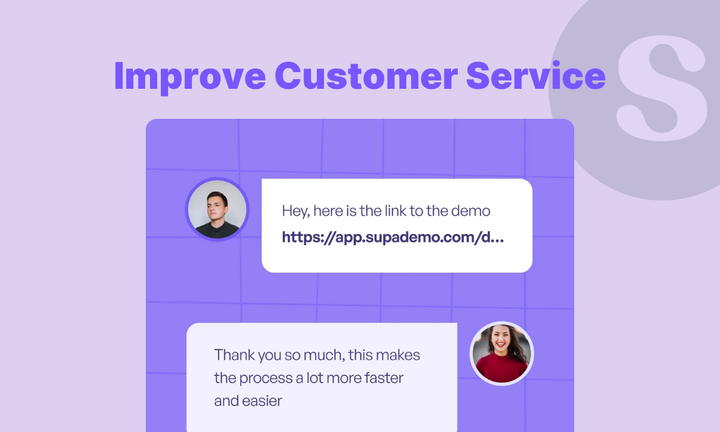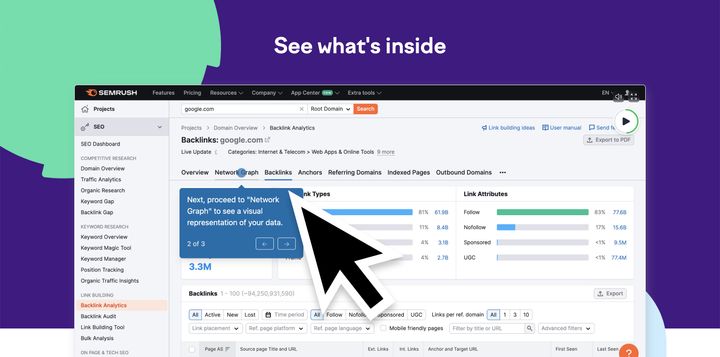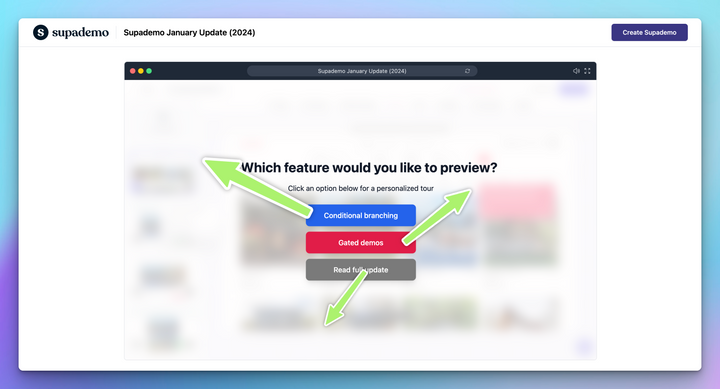TL;DR
See why simplifying onboarding and equipping employees with tools like Supademo’s interactive demos accelerates adoption and reduces friction. These insights will help your bank stand out by making every customer interaction a moment of value.
A 10x Banking study revealed that 20% of customers leave their bank because of poor experiences, and almost two-thirds of banking leaders admit that slow digital progress has made it harder to attract new business.
True progress isn’t about more apps or features. It starts with understanding customer needs and designing experiences that feel effortless and personal.
The good news? Improving customer service in banks doesn’t require a complete overhaul. It’s about identifying weak points, rethinking touchpoints, and using technology to make banking feel more human.
This guide breaks down ten proven strategies that help leading banks deliver faster, smarter, and more empathetic service.
Why is customer service in banks important?
Customer service is the foundation of every strong banking relationship. It shapes how customers perceive trust, reliability, and value—and ultimately determines whether they stay or leave.
Beyond being a support function, it’s a strategic lever that drives revenue, loyalty, and operational efficiency.
Drives loyalty and long-term revenue
Retaining customers is far more profitable than acquiring new ones. A modest 5% lift in retention can increase profits by 25–95%.
When service is fast, accurate, and empathetic, customers are more likely to consolidate products—credit cards, savings, loans—under one trusted institution.
Builds trust in a regulated, high-stakes industry
Customers hand over their money and data expecting absolute security and transparency. Clear communication and responsive support reinforce that confidence.
When banks handle issues quickly, explain policies clearly, and keep customers informed, they strengthen credibility and compliance at the same time.
Strengthens brand reputation and differentiation
Most banking products look the same. What sets leading banks apart is how they treat customers when things go wrong.
Brands like DBS and Ally have built strong reputations by combining digital efficiency with genuine care. Exceptional service becomes a moat—it earns advocacy, drives referrals, and protects reputation even in moments of error.
Reduces complaints and operational costs
Every unresolved query or repeated call adds cost. Streamlined support systems reduce escalations, shorten resolution times, and lower the overall service burden.
When banks invest in training, automation, and better processes, they not only improve satisfaction but also reduce internal friction, freeing teams to focus on higher-value interactions.
9 Effective strategies to improve customer service in banks
Building trust and loyalty is only half the challenge. The next step is turning that intent into consistent, high-quality experiences across every channel and interaction.
Here are ten proven strategies that help banks improve customer service, strengthen relationships, and stay competitive in a fast-changing financial landscape.
1. Deliver personalized communication
Customers expect banks to understand their needs and reach out with relevant, timely information. Personalized communication shows that the bank listens, anticipates, and values each customer relationship.
Here are a few ways you can personalize:
- Use behavioral and transaction data to tailor updates, offers, and advice.
- Match messaging to key milestones like loan renewals, travel, salary credits, or savings goals.
- Communicate through preferred channels like SMS, email, or mobile push notifications.
- Automate outreach with AI while maintaining a human, trustworthy tone.
For example, DBS, via Adobe Experience Cloud, logged a 40% increase in digital engagement when it served contextual, lifestyle-aligned nudges to app users.
2. Create a seamless omnichannel experience
Customers expect a consistent experience wherever they interact. Whether it’s a mobile app, branch visit, or call center, every touchpoint should feel connected and informed.
Here's how you can improve the omnichannel experience:
- Unify customer data across digital, phone, and in-branch systems.
- Ensure agents have full context so customers never repeat information.
- Use AI chatbots to provide 24/7 customer support.
Banks like HSBC and Citi have invested heavily in omnichannel platforms that integrate customer history and preferences, improving resolution time and satisfaction. A unified experience saves effort for both customers and employees.
3. Simplify and digitize the onboarding process
First impressions define customer relationships. A smooth, transparent customer onboarding process signals efficiency and builds early trust.
How to implement:
- Replace paperwork with eKYC, biometric verification, and e-signatures to enable account opening in minutes.
- Map and eliminate friction points by tracking drop-off rates in each step of your digital application.
- Use guided workflows—tooltips, progress bars, and embedded FAQ—to help new users complete forms without frustration.
- Provide real-time support via in-app chat or click-to-call for questions during account setup.
Banks can leverage tools like Supademo to deliver personalized onboarding at scale. For example, you can build interactive onboarding flows tailored to businesses or individual customers, embedding step-by-step tutorials directly within your signup sequence. This ensures every new customer enjoys a seamless, guided onboarding from day one.
Here's an example interactive demo of Wise created using Supademo:
4. Enhance mobile and digital banking experiences
A Deloitte study reveals that 84% of customers utilize online banking, and 72% rely on mobile apps as their primary banking tool. This means that for banks, improving digital banking experiences is non-negotiable.
How to implement:
- Simplify core flows by streamlining navigation, speeding up load times, and removing unnecessary steps through regular usability testing.
- Layer in real-time insights and an AI-powered chat widget so customers can get balance updates or answers without leaving the app.
- Personalize the home screen with dashboards that surface spending trends, savings goals, and relevant product recommendations.
- Strengthen security with biometric logins and two-factor authentication.
This reduces confusion, cuts support tickets, and accelerates feature adoption from day one.
Here's an example of Turo's mobile app demo:
5. Use AI for fraud detection and proactive alerts
AI-driven monitoring can detect suspicious activity in real time—stopping fraud before customers even notice.
- Deploy machine-learning models to flag unusual transactions based on behavior patterns and device signals.
- Automate one-click alert workflows that guide customers through verification or card reissuance.
- Integrate fraud alerts into your omnichannel notification system for immediate reach.
- Continuously retrain models on confirmed fraud cases to improve accuracy and reduce false positives.
For example, HSBC’s Dynamic Risk Assessment engine, developed in partnership with Google, analyzes over one billion transactions every month. Since its launch, the system has reduced false positives by 60 percent and uncovered two to four times more financial crime compared to legacy systems.
6. Introduce personalized offers and loyalty programs
A Deloitte study reveals that 73% of customers want personalized loyalty program rewards, yet only 45% of banks currently offer them.
Here's how you can personalize rewards:
- Use customer behavior and spending data to identify relevant product or reward opportunities.
- Apply “next-best-action” models to trigger offers when they’re most useful—like a credit limit boost before travel.
- Build tiered loyalty programs that reward depth of relationship, not just transaction volume.
- Measure redemption and engagement rates to refine offers continuously.
For example, Lloyds Bank’s Club Lloyds program offers tiered lifestyle rewards such as streaming subscriptions and dining deals, and boosts interest rates for customers who set up direct deposits.
The program now has over 1.6 million members, with average balances nearly three times higher than non-members.
7. Train and empower front-line employees
Front-line employees are the face of your bank and the gatekeepers of customer experience. Consistent, confident service depends on well-trained, well-equipped teams.
How to implement:
- Provide the right tools, such as mobile tablets loaded with customer data and decision-support apps.
- Invest in ongoing training covering product knowledge, regulatory compliance, and communication skills.
- Offer role-based training in critical workflows using blended learning formats, including one-on-one coaching, micro-learning modules, and sandbox demo environments.
- Review performance regularly and deliver consistent feedback to reinforce best practices.
Tools like Supademo enable interactive hands-on training at scale. You can create guided walkthroughs of critical workflows, such as KYC verification or loan processing, and embed them in your LMS, intranet, or knowledge base.
With Supademo's built-in analytics, you can track engagement with each module and pinpoint areas where employees need additional support.
8. Reimagine bank branches for the digital era
70% of banking customers expect a smooth handoff between digital and in-branch interactions. They want the flexibility to initiate a transaction online and complete it at a branch without having to re-enter details or explain their situation again.
Leading banks are not stepping away from physical engagement. Bank of America is reimagining the role of its financial centers with a focus on personalization and advice. By 2026, the bank plans to open 165 new locations designed for collaborative consultations instead of teller lines.
"While most clients are using our digital capabilities for their everyday banking, they are visiting our centers for in-person conversations about their more complex financial needs and advice on their life priorities and financial goals."
~ Aron Levine, President of Preferred Banking at Bank of America
How to implement:
- Redesign branches as advisory and experience centers instead of transaction counters.
- Use digital kiosks and appointment systems to reduce wait time and streamline visits.
- Equip staff with CRM-enabled tablets to personalize consultations and capture insights in real time.
- Sync in-branch data with mobile and web platforms so customers never have to repeat information.
When digital convenience combines with human guidance, branches evolve from transaction points into relationship-driven experience hubs.
9. Embrace digital transformation
McKinsey reports that only 30% of banks successfully execute their digital strategies. The rest stall because of outdated systems, siloed teams, and a slow pace of change.

True digital transformation is not a one-time project but a continuous process that connects technology, people, and culture.
How to implement:
- Tackle legacy systems early to improve data flow and reduce technical debt.
- Measure value continuously by tracking the impact of digital investments on satisfaction, revenue, and cost.
- Adopt agile ways of working with small, empowered teams that learn and adapt quickly.
- Partner with fintechs and cloud providers to scale innovation and speed to market.
As Peter Pollini, US Banking and Capital Markets Consulting Solutions Leader at PwC, notes,
“If you can create a competitive advantage with your migration to the cloud, that could give you a market-share-boosting head start that lasts for many months.”
Customer experience is now the true differentiator in banking
Banks are no longer competing on interest rates or branch networks. They are competing on experience.
As AI, automation, and digital platforms reshape how customers interact, service quality has become the clearest marker of trust and loyalty. The institutions leading this shift are investing in smarter onboarding, proactive support, and continuous employee enablement to deliver service that feels both fast and human.
Supademo helps banks put that vision into practice. It turns digital transformation into everyday execution through interactive employee training, guided in-app support, and customer self-service experiences that scale.
By simplifying complex workflows and reinforcing consistency, it empowers teams to deliver better service with less effort.
Try Supademo and see how interactive demos can simplify complex banking workflows, improve customer satisfaction, and accelerate employee training.
FAQs
How to improve customer service in the banking sector?
Banks can improve service by personalizing communication, offering real-time support, training employees effectively, and digitizing customer journeys. Simplifying processes, enabling self-service options, and using technology like Supademo for interactive onboarding or training helps deliver faster, more consistent, and human-centered customer experiences.
What are 7 qualities of good customer service?
Good customer service in banking is defined by empathy, accuracy, responsiveness, transparency, consistency, active communication, and trust. These qualities ensure customers feel understood and supported while reinforcing the bank’s credibility and long-term relationships.
Why is customer service important in banks?
Customer service directly affects trust and loyalty in banking. A positive experience encourages customers to stay longer, open more accounts, and recommend the bank to others. In contrast, poor service can quickly lead to churn and reputational loss in a highly competitive market.
How can technology improve customer experience in banking?
Technology enables faster service, personalization, and self-help options. Tools like Supademo allow banks to guide users interactively through digital products, reduce support tickets, and train employees more efficiently—making customer experience smoother and more scalable across channels.
How do banks train employees for better customer service?
Banks use a mix of onboarding programs, simulations, and digital learning tools to upskill teams. Interactive platforms like Supademo help deliver hands-on training on workflows, compliance, and systems—ensuring employees can provide accurate, confident, and consistent support to every customer.
How can banks reduce customer complaints?
Reducing complaints starts with identifying recurring pain points and fixing them proactively. Clear communication, quick resolution, and self-service resources like interactive demos or FAQs prevent confusion. Regular training and feedback loops also help maintain consistent service quality across teams and branches.




